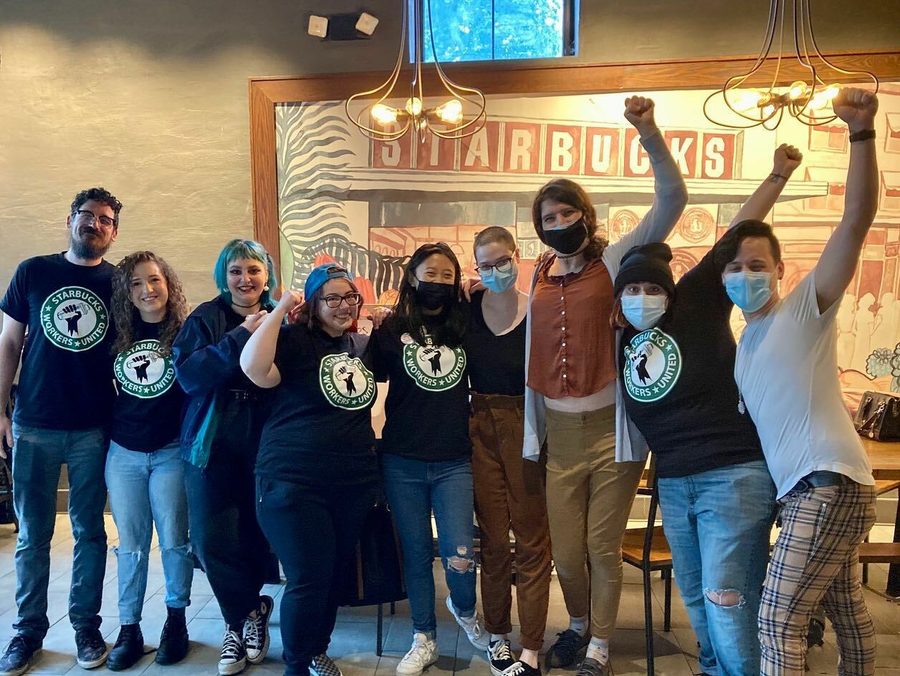The New Labor Movement Is Young, Worker-Led and Winning
From Starbucks and Amazon to political campaigns and digital media, workers in historically unorganized occupations are forming unions—and breathing new life into the U.S. labor movement.
Katie Barrows and Ethan Miller

This year, May Day was celebrated during a historic moment for the American labor movement. Nearly every day, news reports announce another example of workers exercising their rights as nonprofit professionals, Starbucks workers, and employees at corporations like Amazon, REI and Conde Nast announce their union drives. The approval rating for labor unions has reached its highest point in over 50 years, standing at 68 percent, and petitions for new union elections at the National Labor Relations Board increased 57 percent during the first half of fiscal year 2021.
Three years ago, we wrote an op-ed about how young workers in historically unorganized occupations — such as digital journalism, higher education and nonprofit organizations — were beginning to rebuild the labor movement. Today, Covid-19 has changed the way that we relate to work and created new sources of economic anxiety, while exacerbating old ones. Yet, young workers continue to fuel the new labor movement as they form new unions to win back a degree of control over their futures in a world fundamentally altered by a global pandemic. With momentum in union organizing and worker activism still growing, it is important to recognize the ways that workers in every industry are helping the labor movement live up to its values and reverse the years-long decline in union density.
Through organizing campaigns at the Nonprofit Professional Employees Union,
we’ve learned that successful new organizing campaigns must be member-led. Recent organizing victories at Amazon in Staten Island and at Starbucks stores across the country have reinforced the importance of workers themselves being empowered to be the drivers of their own organizing campaigns. We’ve also seen this in other traditionally unorganized sectors, such as political campaigns, digital media and tech.
There are a variety of reasons why member-led organizing campaigns tend to be more effective. One is the commitment that worker-led union organizing requires — leading a union organizing campaign is not for the faint of heart. Worker-leaders must be dedicated, and their time and energy investment means they have more skin in the game. Additionally, these workers build genuinely supportive relationships with their coworkers through one-on-one conversations, working in teams on union materials, and happy hours that bring more workers into the organizing drive. The relationships built during a worker-led organizing campaign helps workers to feel supported, as they know that their coworkers have their back. This collective approach also solidifies workers’ resolve to push back on empty rhetoric from their employer.
Member-driven campaigns are also key to combating bosses’ anti-union campaigns. When workers are active in setting campaign strategy, reaching out to their coworkers, and driving the narrative of the union campaign, they can successfully push back on corporate union-busters’ messaging that the union is a “third-party” or “outside agitator” — because workers know that they are their union.
The significance of momentum can not be understated. In all of these newly organized industries, we’ve seen the power a single union victory can have when it sparks a new consciousness among workers who previously didn’t know they could join a union, or didn’t think unions existed that understood and could address their specific concerns. Union wins years ago at Gawker, the Center for American Progress and Kickstarter helped incite the momentum for new organizing, and laid the groundwork for the campaigns we are seeing today.
We’ve also learned the importance of publicizing our unions’ tangible contract gains. Workers want to be a part of a union that’s effective at improving their pay, benefits, and working conditions, so we as a labor movement need to make the public aware of our wins. That’s why our union and others in newly organized spaces will shout our wins from the rooftops with press releases, social media posts, news stories, and through any other means that will spread the word.
Today’s unions are making incredible gains and raising workplace standards. For example, members of our union at the Center for American Progress recently won a new contract that raised starting salaries by 20 percent over three years, secured annual raises of between 2−2.5 percent, and codified junior staff’s right to be credited on research and policy publications that they work on. Union members at G/O Media ratified a new contract that raised the organization’s salary floor to $62,000, includes trans-inclusive healthcare and prevents forced relocation for remote staff. At NPR, union journalists won 20 weeks of paid parental leave, a hiring process that commits to interviewing more candidates from underrepresented groups, and regular pay equity reviews. The more folks outside of the labor movement know about these victories, the more they will want to learn more about forming a union in their own workplaces.
Millennials and Gen Z are excited, energized, and winning new gains and a new sense of power at work. For the labor movement to continue to grow, we must learn from each other, continue implementing the strategies that are winning union organizing campaigns, and support new, young leaders.

I hope you found this article important. Before you leave, I want to ask you to consider supporting our work with a donation. In These Times needs readers like you to help sustain our mission. We don’t depend on—or want—corporate advertising or deep-pocketed billionaires to fund our journalism. We’re supported by you, the reader, so we can focus on covering the issues that matter most to the progressive movement without fear or compromise.
Our work isn’t hidden behind a paywall because of people like you who support our journalism. We want to keep it that way. If you value the work we do and the movements we cover, please consider donating to In These Times.
Katie Barrows and Ethan Miller are the President and Secretary-Treasurer of the Nonprofit Professional Employees Union, IFPTE Local 70, which is made up of the staff of 49 organizations in Washington, DC and across the country.



